Mortimer Cook (1826-1899), born in Mansfield, Ohio, founded the town of Bug on the northern shore of the Skagit River in 1885 and soon renamed it Sedro. His lasting legacy was building the first drying kiln to reduce the weight of the western red cedar in his sawmill, making rail shipment of the wood more competitive. Cook had founded a town before, Cook's Ferry in British Columbia, after coming to the Northwest during the 1858 Fraser River gold rush. And Cook had built a fortune in California as a banker and as mayor of Santa Barbara before moving his family to the Skagit River. He died in the Philippines in 1899.
Becoming a Businessman
Mortimer Cook (1826-1899) was born in Mansfield, Ohio, and joined the military when he was 19 years old. After serving in Mexico and along the border, he ended up in California and then joined the rush north for gold on the Fraser River in British Columbia. Cook took advantage of business opportunities. Where Spence's Bridge is today on the Thompson River in the province, north of Lytton, Cook operated a ferry starting in 1861, hence the location's earlier place name, Cook's Ferry. He then traveled back east to Kansas, near Topeka, where he built the area's first iron bridge. Cook returned to his hometown in Ohio in 1864 to marry Nan Pollock.
Upon selling the iron bridge for $100,000, Cook returned to California, where he became a banker in Santa Barbara and that town's mayor in the 1870s. But the good days didn't last. In 1878, Cook lost much of his fortune when a severe drought killed off millions of sheep and his investment in them. He ventured north to the Puget Sound for a new beginning.
Arrival on the Skagit
In June 1884, Mortimer Cook arrived by sternwheeler steamboat at Jesse B. Ball's logging camp and trading post, called Ball's Landing, which was in Sterling, 25 miles from the mouth of the Skagit River. Cook immediately begain buying up timber stands with the $10,000 gained from selling his palatial Santa Barbara mansion. Over the next ten years, Cook acquired rights for 2,200 acres of forest that ranged north from the shore of the Skagit River, up and over what is now Duke's Hill, to the area now called Warner's Prairie. John Warner, the prairie's namesake, had been Cook's companion in the California goldfields, during the 1858 Fraser River gold rush, and at Cook's Ferry.
Cook hired carpenter David Batey -- one of the area's two original settlers, along with Joseph Hart -- to construct the first general store in what became Sedro, right next to Cook's wharf on the river. The store stood where Sedro-Woolley's Riverfront Park barbecue pits are now. Batey also built the Cook family home just up the slope, with all the modern furnishings. On June 25, 1885, Cook moved his family -- his wife and two daughters -- up from Santa Barbara to join him, and on December 7 he established a post office named Sedro.
Mosquitoes Dive-Bomb Townsite
Cook had originally named the town "Bug," founded on 34 acres that he bought outright from pioneer William Woods. The name derived from the mosquitoes that bedeviled loggers in the swamps north of the river -- loggers swore the bugs were the size of bats. Cook even had Batey paint a sign on his general store with the unusual moniker, and goods were shipped to that address, so the story goes.
But other settler families were not fond of the name, not least because they feared that denigrators would append the prefix "hum-" to it. So Cook apparently changed the first letter of cedro, the Spanish word for "cedar," to come up with the formal town name of Sedro.
New-Fangled Mill
Cook built a sawmill in 1885 for all kinds of timber, and in May 1886 he began to specialize in milling cedar shingles. His shingle mill was the first one of its kind in the county and possibly the first in the Northwest: It incorporated a drying kiln to reduce the moisture content of sawn timber by up to 35 percent for rail shipment. Western red cedar became the wood of choice because of its resistance to warping, rot, and insects. More than a dozen shingle mills sprang up in the upper Skagit River area by the turn of the twentieth century.
Cook's mill burned on April 9, 1889, but he had sold it in October of the year before to the McDonald & McEwan Company Although his mill was never as financially successful as Cook hoped, his foresight about shingles was the key to Sedro's early growth. Cook's land also became very valuable in 1888 when the Fairhaven Land Company came shopping in anticipation of building a railroad to Bellingham Bay -- what became the Fairhaven & Southern Railway. By then, Cook had decided that he wanted to raise hogs; he established a farm four miles west of town on a muddy trail that became the present Cook Road.
Bankrupt Again
Cook nearly went bankrupt again during the depression of the 1890s, and he liquidated his assets to travel to the Philippines in search of another fortune in the mahogany forests there. On November 22, 1899, he died of dysentery on Iloilo Island, where he is buried. His family moved away to Illinois after the turn of the twentieth century, and Cook's local fame fell through the cracks of history.

